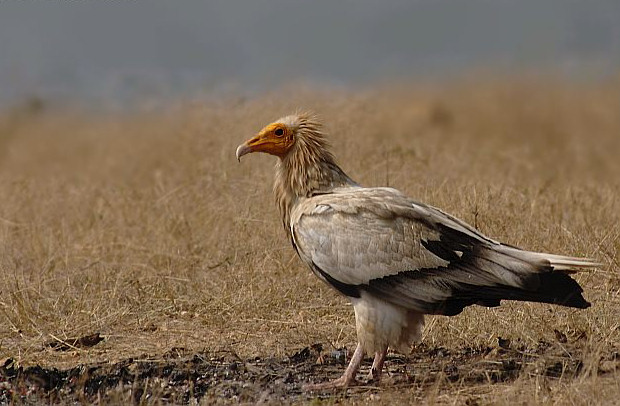|
| 질의: brown hyena | 결과: 35번째/51 | |
Egyptian Vulture (Neophron percnopterus) - Wiki
| 제목: | Egyptian Vulture (Neophron percnopterus) - Wiki
| |

| 해상도: 620x406
파일크기: 84412 Bytes
등록시간: 2006:12:23 13:55:04
|
Egyptian Vulture
From Wikipedia, the free encyclopedia
[Photo] Egyptian Vulture. Photographed by Kousik Nandy. Date Jan 3, 2005.
The Egyptian Vulture (Neophron percnopterus) is a small Old World vulture, the only member of the genus Neophron. Egyptian Vultures are scavengers, mainly feeding off carrion, but they also prey on small mammals and eggs.
The adult Egyptian Vulture usually measures 85 cm from the point of the beak to the extremity of the tail and 1.7m between the tips of the wings. It weighs about 2.1 kilograms.
The adult's plumage is black and white. Its facial skin is yellow (it turns orange during nesting periods) and devoid of feathers. The tail is wedged and easily distinguished in flight. The nestlings are dark brown and gradually go light until they reach adulthood at the age of 5.
The Egyptian Vulture is also known as Pharaoh’s Chicken because it looks like a scruffy chicken.
Egyptian Vultures are quite widely distributed and can be found in India, south west Asia, the Iberian Peninsula, and central and north Africa. They are partial migrants, depending on the local climate. If the Egyptian Vulture can endure the local winter it will usually not migrate. It is not well adjusted to cold weather conditions, mainly because of its surface area-volume ratio that causes a quick loss of heat.
Nesting
The Egyptian Vulture reaches sexual maturity at the age of 5 and breeds like most other birds of prey. They mate for life. The nests are built in areas of cliffs and slopes in inaccessible ledges or niches in rocky walls. Both the male and the female take part in the nest construction. They use branches for the frame and upholster it with garbage and food remains (skeletons of small mammals, turtle shells, etc.). They carry the nesting materials with their beak, unlike most other raptors, which use their talons instead. The nest is continually upholstered during the nesting and brooding period. The female lays 2 white eggs with dark brown spots (measurements: 94 grams in weight, 65x55 millimeter length and width) with a few days interval between them. This usually happens between the end of March and the end of April.
Food
The Egyptian Vulture feeds mainly off carrion. Due to its relatively small size, it needs to wait until other scavengers (such as the larger Gyps vultures and hyenas) finish their meal before it can start feeding. Its head and beak are well fitted for this situation. Like other vultures, it is believed that the bare skin prevents remains from sticking to it. (If a vulture did have feathers, remains could stick to them and interrupt take-off and flight.) Using its long beak an Egyptian Vulture can tear small pieces of meat left by larger scavengers. The thin beak can also fit through narrow spaces between bones to get food that large-beaked vultures cannot reach.
The Egyptian Vulture sometimes preys on small and slow mammals and reptiles, especially turtles. It lifts the turtle to high elevation and drops it on rocky surface, smashing its shell. The Egyptian Vulture is one of a few bird species that are known to use tools. It uses small stones to crack ostrich eggs by lifting a stone with its beak and hitting the egg in a strong swing of head and neck.
http://en.wikipedia.org/wiki/Egyptian_Vulture
| The text in this page is based on the copyrighted Wikipedia article shown in above URL. It is used under the GNU Free Documentation License. You may redistribute it, verbatim or modified, providing that you comply with the terms of the GFDL. |
|
댓글 |
|---|
| | 손님 |
|
Scientific Name: Neophron percnopterus (Linnaeus, 1758)
Common Names: Egyptian Vulture, Egyptian Eagle
French: Percnoptère d’Égypte, Vautour percnoptère German: Schmutzgeier Spanish: Alimoche común
Taxonomy: Vultur Perenopterus [sic] Linnaeus, 1758, Egypt. |
^o^
동물그림창고 똑똑전화 누리집
^o^
|
|
|